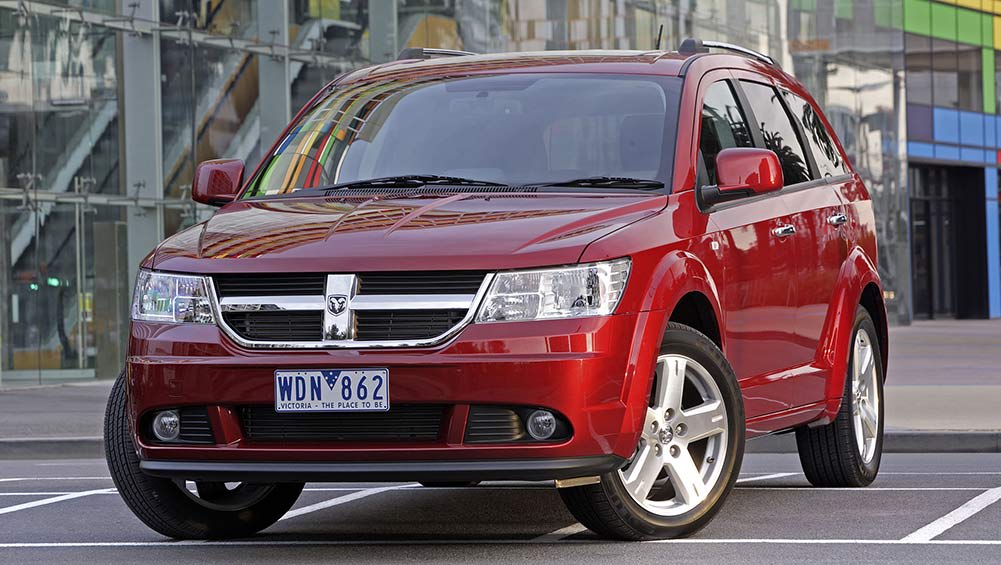
Used Dodge Journey Review: 2008-2015
Ewan Kennedy reviews the 2008, 2012 and 2015 Dodge Journey as used.
While the Dodge Journey looks like a macho SUV, perhaps even all-wheel drive, it's actually a reasonable vehicle with three rows of seats and the ability to carry seven adults. Four adults and three children is a more realistic workload.
Note that this is a 2WD, front wheel only, so it shouldn't be taken off the beaten track. Dirt roads and forest trails are fine if you know what you're doing, beaches are a definite no-no.
Americans love their minivans, and the Dodge Journey has been a big hit across the Pacific, but sales here have only been moderate since it first hit the bottom in August 2008.
Despite being relatively large, the Dodge Journey is fairly easy to drive.
The Journey's interior is very varied; the second row seats three and can slide back and forth so you can juggle legroom with those in the very back seats. Getting in and out of the third row seats isn't too bad, but as usual, these seats are better suited for kids as flexibility is required. Also check the legroom in the back if there are big babies there.
The second and third row seats are positioned slightly higher than the front to improve forward visibility.
There are plenty of places to store various items, including two bins under the rear floor. The backrest of the front passenger seat folds down to leave room for the driver.
Though it’s relatively large, the Dodge Journey is quite easy to drive as it’s more than the typical American minivan. However, forward-side visibility is hampered by large windscreen pillars that sit a long way forward of the driver’s seat. A turning circle of almost 12 metres doesn’t assist manoeuvring in carparks.
Handling of the Journey is competent enough – for a people mover, that is – and unless you do something really silly you aren’t likely to get into trouble. Electronic stability program, to assist in crash avoidance, is standard in all Journeys.
Power is by either a V6 petrol or four-cylinder turbo-diesel engine. The petrol unit in the original 2008 model had a capacity of 2.7 litres and had barely enough performance. Try for yourself on hilly roads with a bunch of passengers on board if you’re likely to be travelling with that sort of load in those conditions. From March 2012 a far more suitable V6 petrol, now of 3.6 litres, improved things considerably.
The Dodge Journey's 2.0-liter diesel engine may be slow, but once it's up and running, it has good torque for overtaking and climbing.
At the same time as the larger petrol engine was introduced in 2012, the Journey received a facelift and rear end, as well as some interior upgrades, the latter including a new dashboard design.
The Journey has good under bonnet space and home mechanics can do a fair bit of their own work. Don’t touch the safety items, though.
Parts prices are about average. We've heard complaints about the lack of bits and the long wait for parts from the US. It might be worth checking with your local Dodge/Chrysler dealer to talk about this before making a purchase. Fiat and Chrysler work together all over the world these days, so Fiat dealers can help.
The insurance companies seem to look at the Journey like an SUV and charge accordingly. Having said that, the prices are about average for this class.
What to look for
Dodge Journey is made in Mexico to a fairly high standard. It has good paint and panel fit, but the interior and trim isn't always as neat and tidy as in Japanese and Korean cars.
Look for damage to carpets, seats, and door upholstery for signs of poor assembly or damage caused by unfortunate children.
Gasoline engines should start almost immediately. If not, then there might be problems.
Diesel engines may take a few seconds to start, especially when cold. The warning light indicates when the engine has passed the preheat phase.
Automatic transmissions should work smoothly and easily, but that in the diesel might be a bit recalcitrant at times at very slow speeds. Get a professional to check it if you have any doubt.
Brakes should pull you up in a straight line without wavering.
Uneven tire wear can be caused by poor driving or suspension failure. Either way, it's a good sign to stay away from the car.
